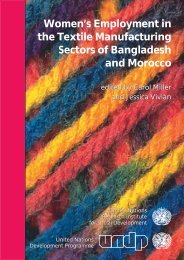communicating in the information society - United Nations Research ...
communicating in the information society - United Nations Research ...
communicating in the information society - United Nations Research ...
You also want an ePaper? Increase the reach of your titles
YUMPU automatically turns print PDFs into web optimized ePapers that Google loves.
What About Gender Issues <strong>in</strong> <strong>the</strong> Information Society?<br />
<strong>in</strong>formation and communication technologies are gender neutral and<br />
that women must adapt to technologies, ra<strong>the</strong>r than have ICT<br />
policy specifically formulated to meet <strong>the</strong> <strong>in</strong>terests and needs of women.<br />
It is becom<strong>in</strong>g clear that without active <strong>in</strong>tervention by gender activists,<br />
new ICTs are unlikely to make a positive contribution to gender equality,<br />
susta<strong>in</strong>able development and democratization of communications.<br />
Experts <strong>in</strong> gender and ICT issues consider that “<strong>the</strong>re is substantial<br />
evidence to support <strong>the</strong> contention that policy mak<strong>in</strong>g <strong>in</strong> technological<br />
fields ignores gender issues” (Hafk<strong>in</strong> 2002:3). Gender analysis has<br />
advanced substantially <strong>in</strong> social and economic fields, but is rarely used<br />
when it comes to <strong>the</strong> consideration of <strong>in</strong>formation and communication<br />
technologies. Gender differences and disparities have been ignored <strong>in</strong><br />
policies and programmes deal<strong>in</strong>g with <strong>the</strong> development and dissem<strong>in</strong>ation<br />
of improved technologies. As a result, women have benefited less<br />
from, and been disadvantaged more by, technological advances. Women,<br />
<strong>the</strong>refore, need to be actively <strong>in</strong>volved <strong>in</strong> <strong>the</strong> def<strong>in</strong>ition, design and<br />
development of new technologies <strong>in</strong> order to avoid new forms of exclusion<br />
and ensure that women and girls have equal access and opportunities <strong>in</strong><br />
respect of <strong>the</strong> developments of science and technology (APC WNSP 2001).<br />
An evaluation of gender relations <strong>in</strong> a telecentre <strong>in</strong> an<br />
underprivileged neighbourhood found that parents did not want <strong>the</strong>ir<br />
children, especially girls, to go to <strong>the</strong> telecentre, because <strong>the</strong>y considered<br />
it a “den of ruffians”—<strong>the</strong> telecentre had a special programme for out-ofschool<br />
youth. Less than 2 per cent of users were girls. Evaluators saw<br />
that <strong>the</strong>se girls hardly used <strong>the</strong> computers. Instead, <strong>the</strong>y sat beside <strong>the</strong><br />
boys and watched how <strong>the</strong>y surfed <strong>the</strong> Internet, played games and<br />
worked on <strong>the</strong> computer. All of <strong>the</strong> tra<strong>in</strong>ers, managers and technical<br />
support staff of <strong>the</strong> telecentre were males; <strong>the</strong>re were two female<br />
members of <strong>the</strong> staff who provided adm<strong>in</strong>istrative and logistical support.<br />
The management realized that <strong>the</strong> lack of participation of girls <strong>in</strong> <strong>the</strong><br />
telecentre was <strong>in</strong>dicative of <strong>the</strong> <strong>in</strong>itiative’s failure <strong>in</strong> meet<strong>in</strong>g <strong>the</strong> needs of<br />
<strong>the</strong> community and young people. New programmes and services for girls<br />
and young women are be<strong>in</strong>g planned to overcome this situation. This is<br />
an example that should be looked at <strong>in</strong> a wider context: what should<br />
policy makers do to ensure that <strong>the</strong> gender gap will be closed <strong>in</strong> <strong>the</strong> ICT<br />
field?<br />
Educational programmes foster<strong>in</strong>g <strong>the</strong> use of ICTs among women,<br />
particularly girls and young women, are highly <strong>in</strong>strumental and gender<br />
<strong>in</strong>sensitive. There is a need to develop educational projects that<br />
stimulate critical and creative skills, and encourage greater participation<br />
of women <strong>in</strong> <strong>the</strong> design and production of new technologies. Lack of<br />
acknowledgement of gender <strong>in</strong>equities <strong>in</strong> all <strong>the</strong> social areas, and <strong>in</strong> <strong>the</strong><br />
technological and scientific fields <strong>in</strong> particular, is responsible for <strong>the</strong><br />
absence of gender-fair policies <strong>in</strong> this area. Many women lack <strong>the</strong><br />
19
















